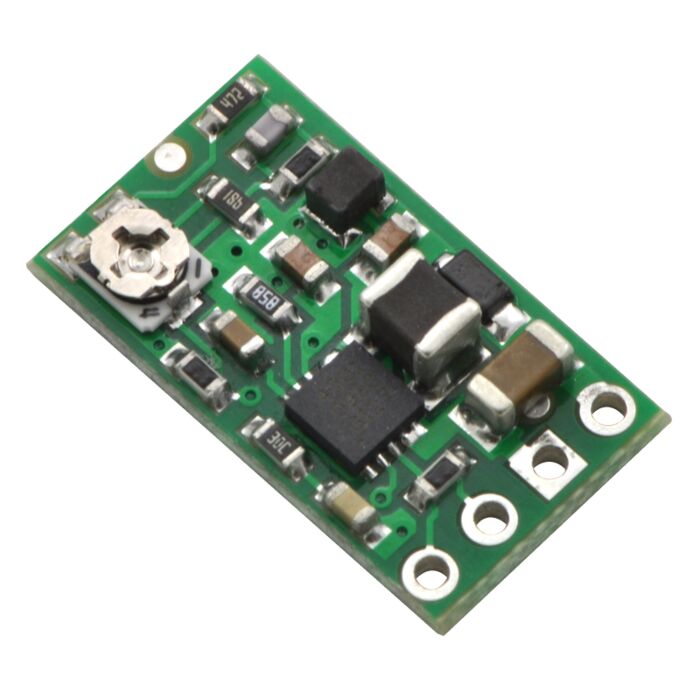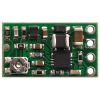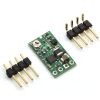Pololu Adjustable Step-Up/Step-Down Voltage Regulator S8V3A
Retired Product
Search for an alternative |
Overview
The Pololu step-up/step-down voltage regulator S8V3A is a switching regulator (also called a switched-mode power supply (SMPS) or DC-to-DC converter) with a single-ended primary-inductor converter (SEPIC) topology. It takes an input voltage from 1.5 V to 12 V and increases or decreases the voltage to a user-adjustable output voltage between 2 V and 12 V. The input voltage can be higher than, lower than, or equal to the set output voltage, and the voltage is regulated to achieve the set output voltage.
This flexibility in input voltage is especially well-suited for battery-powered applications in which the battery voltage begins above the desired output voltage and drops below the target as the battery discharges. Without the typical restriction on the battery voltage staying above the required voltage throughout its life, new battery packs and form factors can be considered. For instance, a 4-cell battery holder, which might have a 6 V output with fresh alkalines but a 4.8 V nominal voltage with NiMH cells and a 4.0 V output with partially discharged cells, can now be used for a 5 V circuit. A single lithium-polymer cell can run a 3.3 V device through its whole discharge cycle. In another typical scenario, a disposable 9V battery powering a 5 V circuit can get completely discharged to 1.5 V instead of cutting out at 6 V, as with typical linear or step-down regulators.
The S8V3A regulator has a shutdown feature that can also be used as an under-voltage protection mechanism for batteries that respond poorly to being over-discharged. The shutdown threshold can be set with one external resistor; please see the Shutdown section below for details.
 |
This regulator can deliver 300 mA continuous in typical applications where the output voltage is not too far from the input voltage. The regulator has under-voltage protection, and thermal shutdown prevents damage from overheating; the board does not have reverse-voltage protection. For applications where the output is significantly different from the input, a regulator optimized for boosting (stepping up) or bucking (stepping down) is more efficient, but for small applications where efficiency is not a top priority, this board can be a convenient, general-purpose regulator to give your system a wide range of supported input voltages.
For a similar regulator with higher efficiency, consider Pololu's step-up/step-down voltage regulator S7V8A.
Features
- output voltage that can be higher than, the same as, or lower than the input voltage
- recommended input voltage: 1.5 V to 12 V
- output voltage adjustable between 2 V and 12 V
- typical continuous output current: 300 mA (Actual continuous output current depends on input voltage. See Typical Efficiency and Output Current section below for details)
- 1.5 MHz switching frequency
- integrated over-temperature protection
- small size: 0.40" x 0.70" x 0.15" (10 x 18 x 4 mm)
 |
| Pololu step-up/step-down voltage regulator S8V3A with included hardware. |
|---|
Using the Regulator
During normal operation, this product can get hot enough to burn you. Take care when handling this product or other components connected to it.
Connections
The step-up/step-down regulator has 4 connections: input voltage (VIN), ground (GND), output voltage (VOUT), and shutdown (SHDN).
The input voltage, VIN, should be between 2 V and 12 V. GND should be at 0 V. Inputs below 1.5V can shut down the voltage regulator; inputs above 16V can destroy the regulator. Therefore, you should ensure that noise on your input does not exceed the 16 V maximum, and you should be wary of destructive LC spikes (see below for more information).
The output voltage, VOUT, is determined by the trimmer potentiometer position. See the Setting the Output Voltage section below for details.
Shutdown
If the voltage on the SHDN pin drops below 1.1 V, the regulator will turn off. The SHDN pin is pulled up to VIN by a 130 kΩ resistor; by adding a resistor between SHDN and GND, you can set the shutdown voltage by making the SHDN pin cross 1.1 V when your input voltage crosses your desired threshold. If Pololu call that threshold VOFF, the equation for the resistor to connect from SHDN to GND is:
 |
For example, if you want to set VOFF to 4 V, so that your battery does not discharge below 4 V, you should connect a 40kΩ resistor between SHDN and GND. The shutdown circuitry has a 0.6 V hysteresis; after the input voltage falls below VOFF the regulator will not turn back on until the voltage rises above VOFF + 0.6 V.
Setting the Output Voltage
The output voltage can be measured using a multimeter. Turning the potentiometer clockwise increases the output voltage. The output voltage can be affected by a screwdriver touching the potentiometer, so the output measurement should be done with nothing touching the potentiometer.
 |
| Output voltage settings for the step-up/step-down voltage regulator S8V3A. |
|---|
Typical Efficiency and Output Current
The efficiency of a voltage regulator, defined as (Power out)/(Power in), is an important measure of its performance, especially when battery life or heat are concerns. As shown in the graphs below, this switching regulator typically has an efficiency of 55% to 65%. The maximum achievable output current of the board depends on many factors, including the ambient temperature, air flow, heat sinking, and the input and output voltage. See the graphs below for more details on the typical efficiency and output currents for this voltage regulator.
LC Voltage Spikes
When connecting voltage to electronic circuits, the initial rush of current can cause voltage spikes that are much higher than the input voltage. If these spikes exceed the regulator’s absolute maximum voltage (16 V), the regulator can be destroyed. In Pololu's tests with typical power leads (~30" test clips), input voltages above 10 V caused spikes over 16 V. If you are connecting more than 10 V or your power leads or supply has high inductance, Pololu recommend soldering a 33μF or larger electrolytic capacitor close to the regulator between VIN and GND. The capacitor should be rated for at least 25 V.
More information about LC spikes can be found in Pololu's application note, Understanding Destructive LC Voltage Spikes.
Exact shipping can be calculated on the view cart page (no login required).
Products that weigh more than 0.5 KG may cost more than what's shown (for example, test equipment, machines, >500mL liquids, etc).
We deliver Australia-wide with these options (depends on the final destination - you can get a quote on the view cart page):
- $3+ for Stamped Mail (typically 10+ business days, not tracked, only available on selected small items)
- $6+ for Standard Post (typically 6+ business days, tracked)
- $10+ for Express Post (typically 2+ business days, tracked)
- Pickup - Free! Only available to customers who live in the Newcastle region (must order online and only pickup after we email to notify you the order is ready). Orders placed after 2PM may not be ready until the following business day.
Non-metro addresses in WA, NT, SA & TAS can take 2+ days in addition to the above information.
Some batteries (such as LiPo) can't be shipped by Air. During checkout, Express Post and International Methods will not be an option if you have that type of battery in your shopping cart.
International Orders - the following rates are for New Zealand and will vary for other countries:
- $11+ for Pack and Track (3+ days, tracked)
- $16+ for Express International (2-5 days, tracked)
If you order lots of gear, the postage amount will increase based on the weight of your order.
Our physical address (here's a PDF which includes other key business details):
Unit 18, 132 Garden Grove Parade
Adamstown
NSW, 2289
Australia
Take a look at our customer service page if you have other questions such as "do we do purchase orders" (yes!) or "are prices GST inclusive" (yes they are!). We're here to help - get in touch with us to talk shop.
Have a product question? We're here to help!
Guides
The Maker Revolution
Projects
Days2Bin: Pico Powered Bin Reminder
Raspberry Pi Video Looper Display Installation | Overshare Video Festival
Mailbox Delivery Notification System
Makers love reviews as much as you do, please follow this link to review the products you have purchased.
















Product Comments